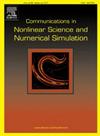Reconfigured continuous normalized accelerated gradient flow for computing ground states of spin-1 Bose–Einstein condensates
IF 3.8
2区 数学
Q1 MATHEMATICS, APPLIED
Communications in Nonlinear Science and Numerical Simulation
Pub Date : 2025-07-01
DOI:10.1016/j.cnsns.2025.109100
引用次数: 0
Abstract
Based on the mean field Gross–Pitaevskii theory, the ground state of a spin-1 Bose–Einstein condensate (BEC) can be modeled as a vector wave function that minimizes the energy functional of the coupled Gross–Pitaevskii equations, subject to conservation constraints on total mass and magnetization. The normalized gradient flow methods are widely used for computing the ground states of spin-1 BECs due to their simplicity in implementation and efficiency in each time step. However, their slow convergence speed requires many iterations to reach the ground state, which results in excessive computational costs. In this paper, we propose a highly efficient method for computing the ground states of spin-1 BECs, based on the rapid convergence properties of accelerated gradient flow. We establish a reconfigured continuous normalized accelerated gradient flow (RCNAGF) to simulate the spin-1 BEC ground state. One explicit and two semi-implicit schemes are presented for the numerical solution of the RCNAGF, incorporating a Fourier pseudospectral method for spatial discretization. Our proposed schemes are efficient at each time step because the explicit scheme can be directly updated, while the semi-implicit schemes only need to solve several linear systems with constant coefficients. All schemes require solving an additional nonlinear algebraic system, but this computational cost is considered negligible. The numerical experimental results indicate that our schemes are more efficient than those based on normalized gradient flow schemes for computing the ground states of spin-1 BECs. Specifically, our explicit scheme allows for larger stable time step sizes, while the semi-implicit schemes significantly reduce the number of iterations required to meet the stopping criterion at the same step size.
用于计算自旋-1玻色-爱因斯坦凝聚体基态的重构连续归一化加速梯度流
基于平均场Gross-Pitaevskii理论,自旋为1的玻色-爱因斯坦凝聚体(BEC)的基态可以建模为一个矢量波函数,该波函数在总质量和磁化的守恒约束下使耦合的Gross-Pitaevskii方程的能量泛函数最小化。归一化梯度流法由于其实现简单,且在每个时间步长的效率高,被广泛用于计算自旋-1 bec的基态。然而,它们的收敛速度慢,需要多次迭代才能达到基态,这导致了过高的计算成本。本文基于加速梯度流的快速收敛特性,提出了一种计算自旋为1的bec基态的高效方法。我们建立了一个重新配置的连续归一化加速梯度流(RCNAGF)来模拟自旋为1的BEC基态。采用傅里叶伪谱法对RCNAGF进行空间离散化,提出了一种显式和两种半隐式的数值解。我们提出的格式在每个时间步上都是有效的,因为显式格式可以直接更新,而半隐式格式只需要求解几个常系数的线性系统。所有的方案都需要求解一个额外的非线性代数系统,但是这个计算成本被认为是可以忽略不计的。数值实验结果表明,我们的格式比基于归一化梯度流格式的格式更有效地计算自旋为1的bec的基态。具体来说,我们的显式方案允许更大的稳定时间步长,而半隐式方案显著减少了在相同步长下满足停止准则所需的迭代次数。
本文章由计算机程序翻译,如有差异,请以英文原文为准。
求助全文
约1分钟内获得全文
求助全文
来源期刊

Communications in Nonlinear Science and Numerical Simulation
MATHEMATICS, APPLIED-MATHEMATICS, INTERDISCIPLINARY APPLICATIONS
CiteScore
6.80
自引率
7.70%
发文量
378
审稿时长
78 days
期刊介绍:
The journal publishes original research findings on experimental observation, mathematical modeling, theoretical analysis and numerical simulation, for more accurate description, better prediction or novel application, of nonlinear phenomena in science and engineering. It offers a venue for researchers to make rapid exchange of ideas and techniques in nonlinear science and complexity.
The submission of manuscripts with cross-disciplinary approaches in nonlinear science and complexity is particularly encouraged.
Topics of interest:
Nonlinear differential or delay equations, Lie group analysis and asymptotic methods, Discontinuous systems, Fractals, Fractional calculus and dynamics, Nonlinear effects in quantum mechanics, Nonlinear stochastic processes, Experimental nonlinear science, Time-series and signal analysis, Computational methods and simulations in nonlinear science and engineering, Control of dynamical systems, Synchronization, Lyapunov analysis, High-dimensional chaos and turbulence, Chaos in Hamiltonian systems, Integrable systems and solitons, Collective behavior in many-body systems, Biological physics and networks, Nonlinear mechanical systems, Complex systems and complexity.
No length limitation for contributions is set, but only concisely written manuscripts are published. Brief papers are published on the basis of Rapid Communications. Discussions of previously published papers are welcome.
 求助内容:
求助内容: 应助结果提醒方式:
应助结果提醒方式:


